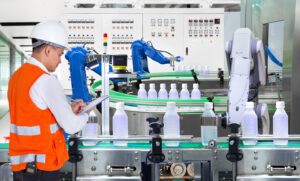As countries around the globe begin to come out of lockdown, it’s clear that many aspects of life will change. One example is temperature screening systems that will likely be required wherever people gather in large numbers, including airports, rail stations, construction sites and more. In effect, these screening systems will be industrial edge solutions that, like any crucial application, will require backup power.

Airports roll out thermal screening
We’re already seeing early examples of such health and security solutions. In May, the CEO of London’s Heathrow Airport laid out plans to trial myriad public safety solutions, with the first being facial recognition thermal screening technology.
Similarly, Paine Field Airport in Everett, Wash., the home airport to the Boeing manufacturing plant, is rolling out thermal cameras to check passengers for fever. “We’re proud to be the first U.S. passenger terminal to roll out this type of technology,” said Brett Smith, CEO of Propeller Airports, which designed and built the terminal. “The use of this system will allow us to maintain the seamless, safe and modern travel experience our customers have come to expect.”
We can expect similar systems in rail stations, bus terminals, manufacturing plants and construction job sites. Indeed, the U.S. Centers for Disease Control and Prevention (CDC) is recommending employers of critical infrastructure workers check each employee’s temperature prior to their shift and before they enter the work area.
In many of these instances it won’t be practical to use hand-held thermometers to check temperatures due to the sheer number of people that need to be tested. Rather, touchless thermal technology that can handle thousands of people per hour will be required.
Why thermal sensor systems need backup power and micro data centers
Such a system requires a significant amount of supporting infrastructure and software in addition to the thermal camera. A complete solution would be housed in an industrial edge micro data center enclosure and may include components such as an automation server, network switch, HID card reader (to prevent unauthorized access), perhaps an environmental surveillance system and definitely an uninterruptible power supply (UPS) for backup power.
Many facilities, like airports and rail systems, will need several such systems strategically located so that they can take readings on people before they venture too deep into the crowd, to weed out any potentially contagious individuals before they infect others.
Need for speed in health and security solutions
And they will need to roll out these systems quickly in order to give the public confidence that it’s safe to once again get on planes, trains, or simply go to work.
That means facility owners will need to find solutions that can deliver all the required components in a turnkey package, ready to roll into their facilities. With that in mind, it is important to search for solution providers who can offer thermal screening solutions as a complete system that includes a display unit, artificial intelligence controllers, network connectivity, industrial UPS and more.
Everyone has a part to play as we re-enter some semblance of normalcy. We are doing our part by resourcing health and security providers with micro data center enclosures, including UPSs, to strengthen the screening solutions that minimize public health risk. Schneider Electric can serve as backbone support to thermal cameras and other health and security solution providers and is ready to provide complete solutions, including all third-party devices of thermal cameras and other health and security solutions. Simply check out our web page.



